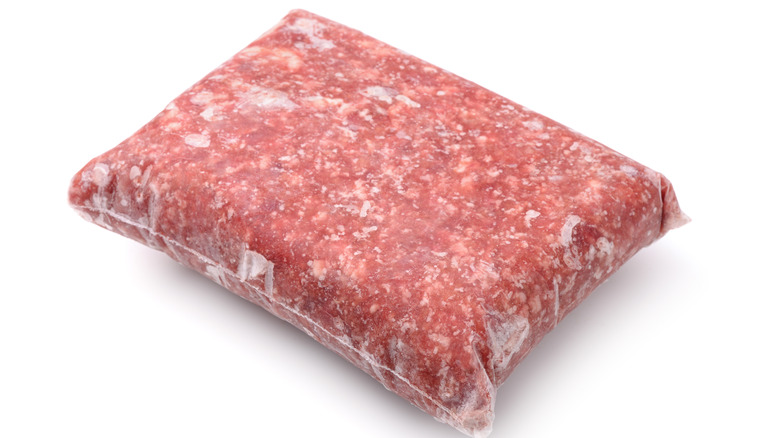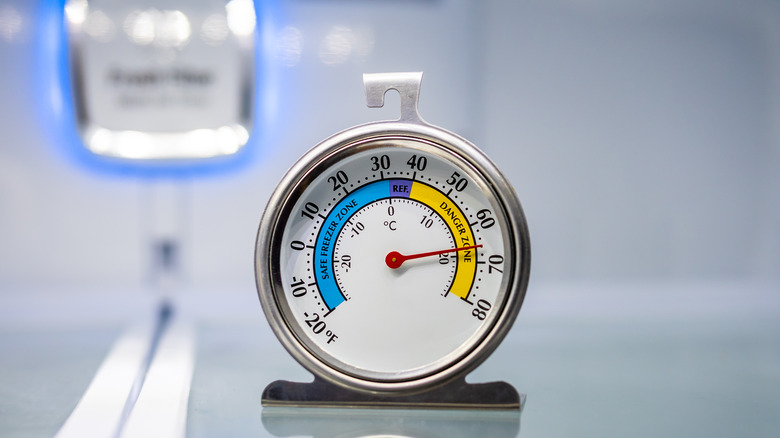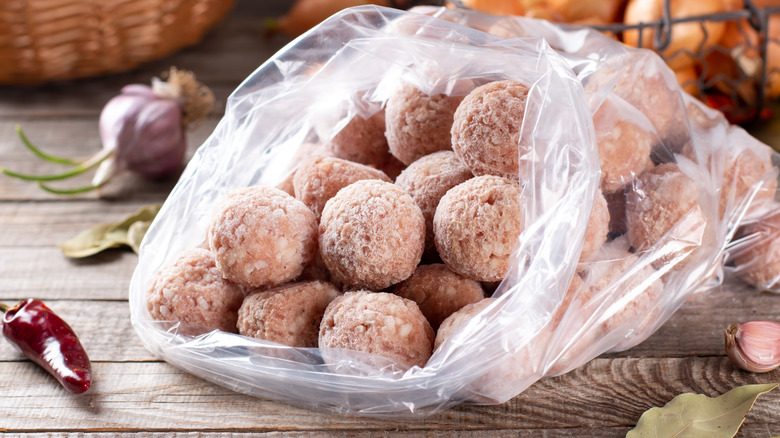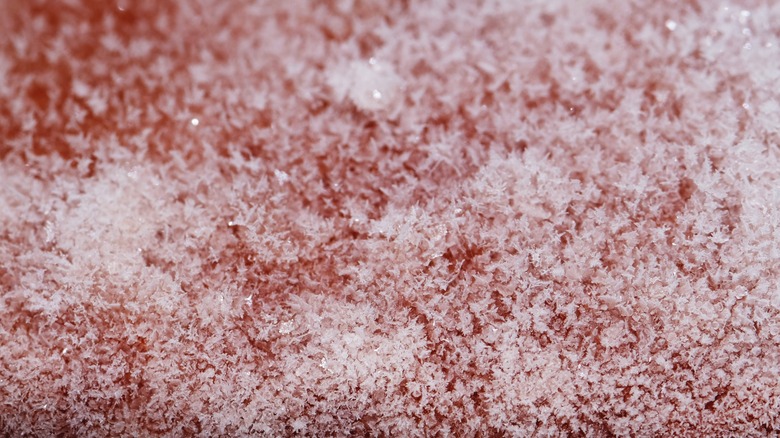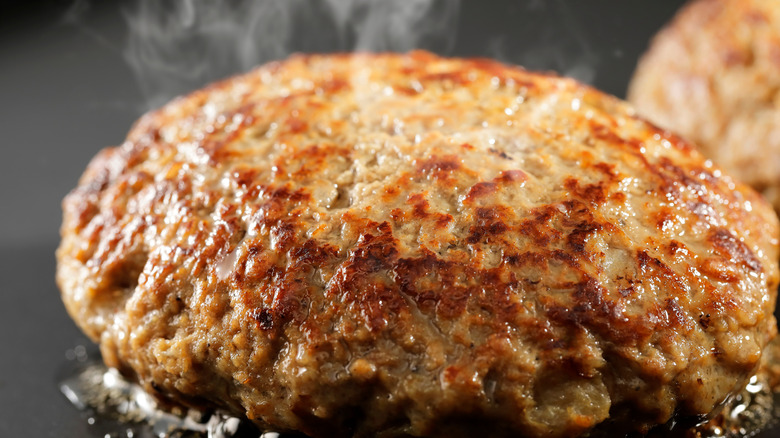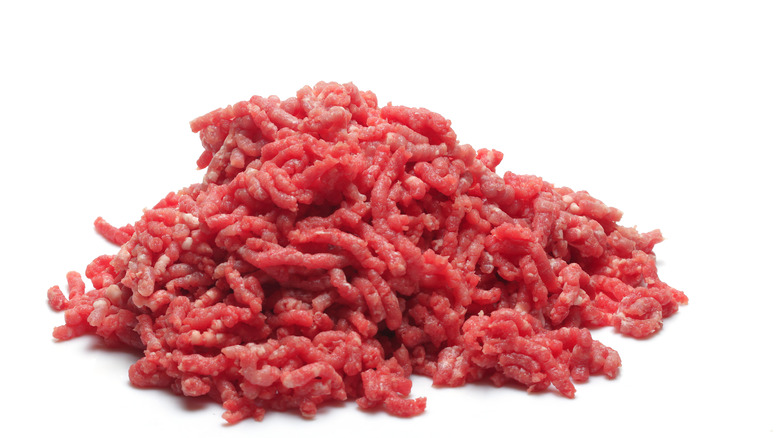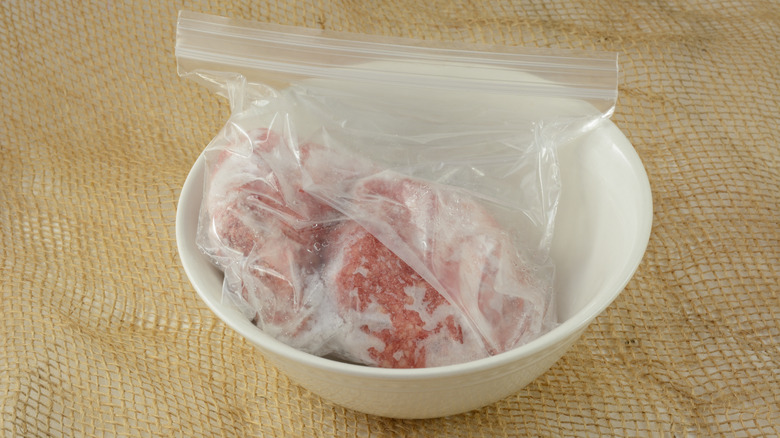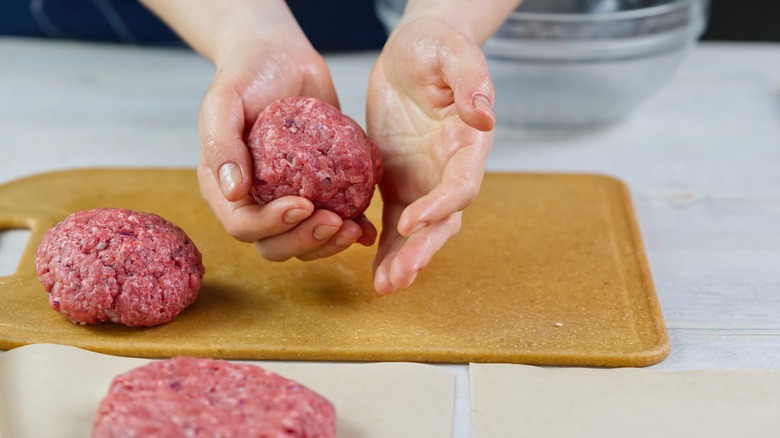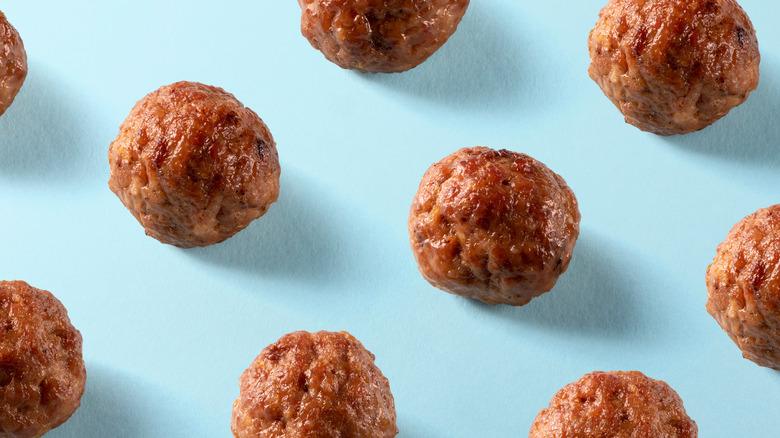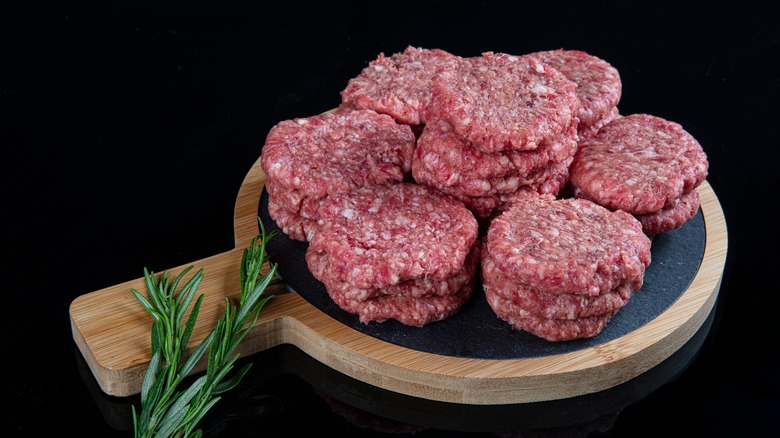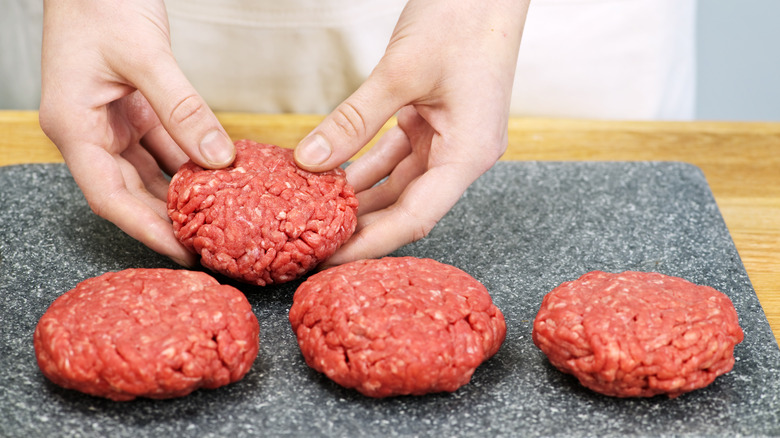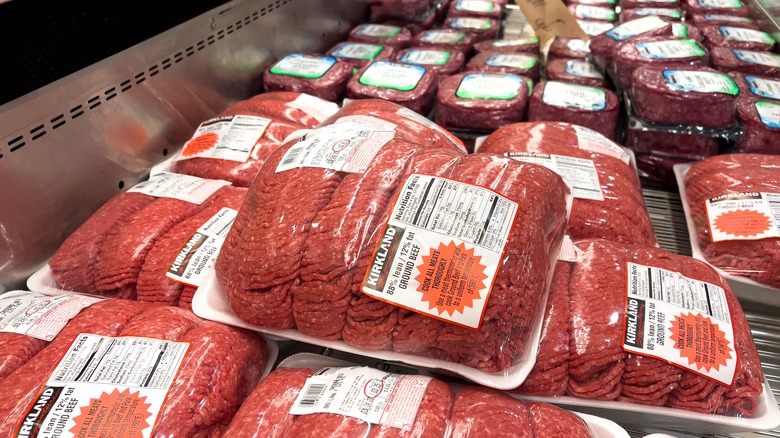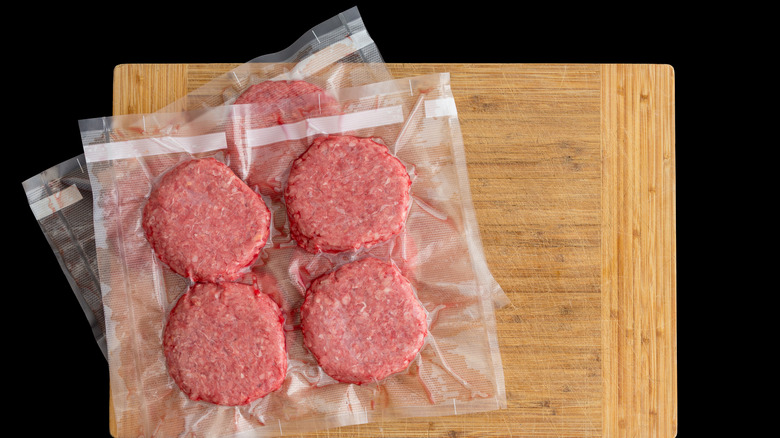The 12 Biggest Mistakes You're Making When Freezing Ground Beef
While the financial news of the day has us scratching our collective heads in confusion, there's one sound bit of financial advice you can count on: Buying ground beef in bulk and freezing some of it for later is a great way to save money. When following this great money-saving habit, it's important to consider how much room you have in your freezer and how much you're saving by buying a larger pack. If you're crowding out your fridge to save a couple of bucks, you may want to stick to smaller portions.
When considering buying in bulk, it's also important to remember that it can be good for the environment. If more people bought food in bulk, it would significantly reduce the need for landfill space (via NPR). On top of that, bulk buyers take fewer trips to the supermarket, which can mean lower carbon emissions.
If you're going to freeze ground beef, you should be aware of some of the more common mistakes that people make. There are also a few common missteps when it comes to storage, thawing, and cooking of frozen beef.
Not checking your freezer temperature
One of the biggest mistakes you could be making when freezing ground beef is not having a freezer that is maintaining the correct temperature. According to the USDA, a temperature of 0 F will prevent microbial growth in meat, allowing ground beef to be stored for long periods. As the temperature of ground beef rises above 0 F, it becomes fertile ground for microorganisms.
Because maintaining a safe temperature is so critical, it is a good idea to keep a freezer thermometer in your freezer and periodically check it to ensure the temperature is not rising above 0 F. If your freezer is not able to maintain this critical temperature, it could be due to several different reasons (via AHS). The first thing to check is if your freezer door is remaining ajar or not staying closed. You should also check to see if the contents of your freezer are blocking the air circulating fan. It's also possible your freezer has a mechanical malfunction. If you suspect this is the case, you should call a repair professional.
Maintaining the temperature of your freezer is also an issue during power outages. The Department of Energy notes a freezer should be able to keep ground beef safe for 48 hours as long as the door is kept closed to retain the cold air. Once the temperature of the freezer reaches 40 F, ground beef will only last for two hours before it is unsafe to eat.
Loosely packaging your beef
Arguably, the biggest concern when it comes to freezing ground beef is avoiding freezer burn. The process that causes freezer burn starts when thousands of ice crystals form as food is frozen. Over time, these frozen water molecules move from the frozen piece of food to a colder part of the freezer, typically the side. As frozen water molecules are lost, the food becomes dehydrated, resulting in freezer burn (via the Library of Congress).
Therefore, one simple method to prevent freezer-burned ground beef is to keep those frozen water molecules contained with tight packaging. Start by wrapping your ground beef in plastic wrap. Next, wrap it with aluminum foil. Finally, put the wrapped ground beef into a plastic bag.
It's also a good idea to label your bag with the date. While wrapping ground beef tightly can help keep freezer burn at bay, this technique only works for so long. According to a study published in the Journal of Food Science, the quality and moisture content of frozen meat starts to deteriorate after two months.
Keeping beef frozen for too long
Because the quality of frozen ground beef can deteriorate after a couple of months, you should plan accordingly. If you are buying ground beef in bulk and freezing it, only buy enough meat you think you can consume within three or four months. While you can safely consume meat that has been frozen for more than four months, the quality of ground beef will deteriorate more the longer you wait (via Healthline).
You can also avoid keeping ground beef frozen for too long by using a first-in, first-out system, notes Gordon Food Service. Start by making sure all of your frozen ground beef is labeled with the date on which it was frozen. Move the most recently frozen packages to the rear of your refrigerator and place the oldest packages toward the front. Use frozen beef from the front of the freezer and work your way backward. Maintain this chronological rotation as you use frozen beef and add fresh beef to your freezer. Regularly inspect dates and throw out older frozen beef if it is covered in ice crystals or appears discolored.
Putting hot beef in the freezer
There is a myth about refrigerating hot food that says a refrigerator isn't capable of safely cooling food that is too warm. Although this myth isn't true, you should stop putting hot food directly into a freezer. If you place freshly cooked, hot ground beef into a freezer, it could cause other foods in the freezer to defrost, potentially allowing microorganisms to proliferate. Hot food also takes longer to freeze, and this could mean a food item spends too much time at temperatures that are hospitable to bacteria, which is 40 to 140 F, according to the FDA.
The proper way to freeze cooked ground beef is to cool it slowly. Start by allowing your cooked beef to come down from its cooking temperature so that it can safely be placed in a container. Then, cover your cooked ground beef and place it in the refrigerator. After the beef has cooled in the refrigerator, tightly wrap it and place it into freezer bags. Label the bags to ensure you are cooked beef does not remain in the freezer for too long (via the University of Nebraska).
Letting beef blood drip on other foods
One of the biggest concerns related to storing raw meat is cross-contamination. If blood from your raw meat drips onto other food products like ice cream containers or popsicles, there is a risk that any pathogens in the blood will proliferate in them. According to the Centers for Disease Control and Prevention, raw ground beef can harbor campylobacter, salmonella, clostridium, E. coli, yersinia, and other bacteria. Hence, any juices from raw meat can carry these pathogens. Furthermore, any containers that have not been properly cleaned can pass residual bacteria along if used to then store raw meat. In significant quantities, these bacteria can cause severe illness and even death.
Restaurants prevent cross-contamination by keeping raw meat in either its original package or clean, sanitized containers that prevent leakage (via the National Restaurant Association Educational Foundation). You also shouldn't store raw and cooked foods together, even in your freezer. Store raw ground beef at the bottom of your freezer. If for some reason any liquid leaks out, it won't drip onto other foods.
Thawing raw ground beef for several hours at room temperature
The recommended method for thawing raw meat is to allow it to slowly defrost in the refrigerator over the course of 24 hours. You should also place your defrosting meat on a large sheet pan or plate that can catch any potential leaks of raw meat juices. This plate or pan should then be placed at the bottom of the refrigerator in case it happens to overflow.
While this process is largely foolproof, sometimes we forget to pull frozen meat out of the freezer one day in advance. In these situations, it may be tempting just skip the recommended method and completely defrost frozen ground beef at room temperature. However, this is one of the biggest mistakes people make when defrosting meat. A refrigerator keeps defrosting meat outside the dangerous temperature zone that facilitates bacterial growth, which ranges from 40 F to 140 F. According to the National Agriculture Library, it is safe to jump-start your defrost at room temperature, but you should only do so for less than two hours. After two hours, you should move your defrosting meat to the refrigerator to complete the process.
Not pre-portioning your meat
There's nothing disastrous about freezing multiple pounds of ground beef as a single block, but unless you're cooking it all at once, safely defrosting the amount you need will be very tricky. A simple, elegant solution to this is pre-portioning your ground beef before cooking it. According to Weight Watchers, the ideal serving size for cooked meat is 3 ounces. Because ground beef loses about 25% of its weight during cooking, each freezer-bound portion should be 4 ounces. For meal prep purposes, simply multiply 4 ounces of raw meat per the number of people in your household. Someone prepping for a household of three, for instance, should measure out 12-ounce portions.
Lifehacker (via Lunch in a Box) offers a clever hack for creating multiple individual portions in the same large freezer bag. Start by portioning out a dinner's worth of ground beef, such as 12 ounces for a three-person household. Next, flatten out the ground beef and use a chopstick to segment the beef into equal-sized individual portions. The flattened portions will defrost much quicker and are less likely to contain air pockets, which can facilitate freezer burn. Be sure to tightly seal and mark your freezer bag. Since this process doesn't involve tightly wrapping the ground beef, it's best for short-term freezing.
Not freezing cooked ground beef
You might be under the impression that freezing cooked beef will ruin it. However, freezing cooked ground beef is a great technique for weekly meal prep. It's important to note that one of the common mistakes everyone makes with meal prep is batch cooking just one dish. To avoid this mistake, you should either cook several dishes at once or cook your ground beef so that it can be used in several different ways. For example, if you cook ground beef with just salt, black pepper, and onions, it could be used to make tacos one night and stir fry the next night.
After cooking your ground beef four different dishes, or with generic seasoning, allow it to cool, first on a counter for about 20 minutes, and then in a refrigerator. Once the cooked ground beef has reached refrigerator temperature, it should be wrapped tightly and transferred to freezer bags (via Canadian Living). When you're ready to use your ground beef, simply thaw it in your refrigerator and reheat it.
Tossing beef that appears to have turned brown
You might have come across ground beef that's turned brown and thought this color has something to do with bacteria growth. However, a section of ground beef that switches from pink to brown doesn't necessarily mean the meat has gone bad. According to the USDA, when fresh beef is first cut, it has an initial purplish color. As beef is exposed to oxygen, a pigment in the meat called oxymyoglobin reacts, causing the meat to turn redder, eventually becoming the signature pink color we see in our supermarket meat department. If sections of meat are not exposed to oxygen, they will remain brown or even grey.
The USDA notes that ground beef that still has a brownish color should be safe to eat. That being said, meat left out in an oxygen-rich environment creates ideal conditions for bacteria to flourish. If bacteria take hold of a piece of meat, they will turn it brown as they grow. However, according to the USDA, if there are no other signs of spoilage, like an off-putting smell, raw brown ground beef should be okay to eat after it has been cooked.
Not bringing your meat up to temperature
If you are making dinner on the fly, it's easy to skip the mise en place, the French culinary term for preparing your ingredients before cooking. When cooking with ground beef, a key part of mise en place is allowing the meat to warm up slightly at room temperature so that you aren't throwing cold meat into a pan.
Getting a good sear on your meat helps to develop a lot of flavors, and when you add cold meat to a hot pan, it's difficult to get a good sear. Additionally, adding a lot of cold meat to a pan can significantly bring down the temperature of the pan, potentially throwing off your cooking process. If you're cooking burgers, cooking them cold also makes it more difficult to ensure the inside is cooked properly.
That being said, you also don't want to cook room-temperature ground beef. Not only are you running the risk of food poisoning, but you are also increasing the chances of overcooking your meat and drying it out. Celebrity chef Bobby Flay recommends leaving a steak on the counter for 20 minutes before cooking it and this is also good advice for cooking ground beef (via Insider).
Not using the original packaging for short-term storage
According to the USDA, it's a good idea to refrigerate or freeze ground beef as soon as possible after you get home from the market. If you plan on freezing your ground beef for only a few days, there's nothing wrong with keeping it in its original packaging. If you're thinking of long-term storage, you should be freezing your ground beef in tightly-wrapped packages.
One of the benefits of using store packaging is that it avoids creating unnecessary waste. A recent study found a big problem with plastic packaging for produce: It does not have any benefit when it comes to preventing spoilage (via The Guardian), and it contributes to the global issue of plastic pollution. According to National Geographic, the amount of plastic trash entering the oceans could triple by 2024 unless significant action is taken to reduce its use. About 14 million tons of plastic enter the earth's oceans each year, creating a massive threat to marine life and food safety, according to the International Union for Conservation of Nature.
Not removing air when you seal your freezer bag
The most important tips for freezing, thawing, and cooking ground beef have to do with avoiding freezer burn. Freezer burn is actually a kind of dehydration that occurs when anything containing moisture is exposed to air (via Inverse). The process is actually quite similar to evaporation. In the same way a bowl of water in your refrigerator would slowly evaporate, ground beef left exposed to the air in your freezer will dehydrate.
According to Inverse, there are two primary considerations when trying to avoid freezer burn: exposed surface area and air inside a container or bag. Tightly wrapping ground beef in plastic before placing it into a plastic bag is one way to limit air exposure inside the bag. You can also prevent freezer burn by limiting surface area. While pre-portioning your ground beef is an effective meal prep strategy, it also increases surface area, and therefore pre-portioned ground beef should be used more quickly than non-portioned ground beef.
Another effective way to prevent air exposure is to use a vacuum sealer. According to PacFood, its vacuum seal system can keep ground meat fresh for one year, while FoodSaver says its vacuum seal system can keep meat fresh for two to three years — about two to four times longer than ordinary storage methods.
